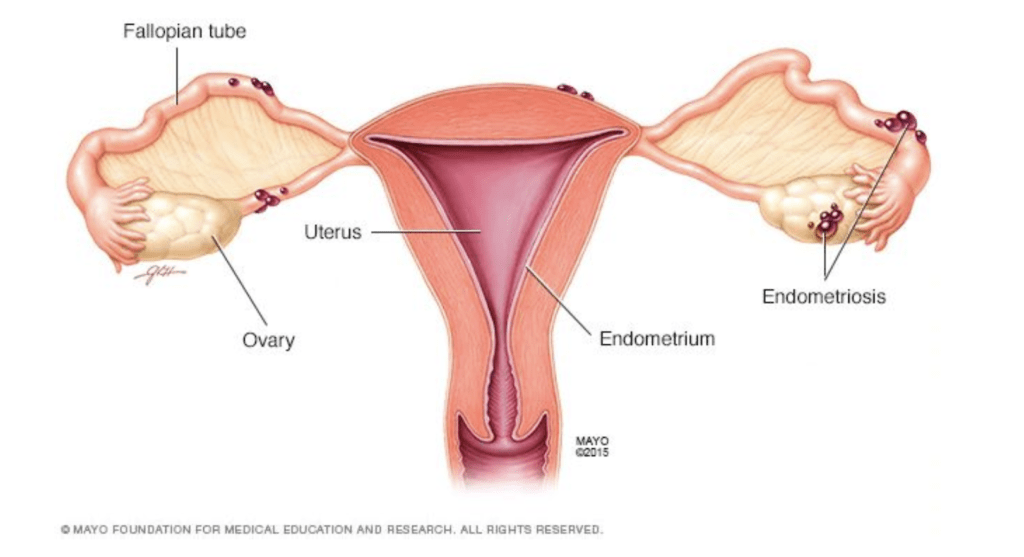What is Endometriosis?
Over the past few years, endometriosis is becoming a common topic of conversation. Endometriosis is a condition which involves tissue similar to that inside the uterus grows in other areas of the body. It most commonly occurs in the ovaries, fallopian tubes and the tissue surrounding the pelvis. The endometrial tissue inside the uterus is the lining which thickens and then breaks down and sheds or bleeds during a period. This is similar to the endometrial like tissue, the same sequences occur but are not able to be expelled by the body, becoming trapped. Endometriosis is graded into 4 different categories; minimal (stage I), minor (stage II), moderate (stage III) and severe (stage IV).

Signs and Symptoms
There are a wide variety of signs and symptoms associated with endometriosis. The most common symptom is pelvic pain. Other symptoms and signs include:
- Excessive bleeding – this can include heavy periods, long duration of periods and/or bleeding in between periods
- Pain leading up to and during a period. This can also include pelvic pain as well as lower back and stomach pain.
- Pain with intercourse
- Pain with bowel or bladder movements
- Having trouble holding on when you have a full bladder or increased urination frequency
- Infertility
- Fatigue
- Bloating
- Constipation or diarrhoea
Studies have shown that the common age that onset of symptoms is around 20 years old for those with period pain and the most common age of diagnosis for those with pelvic pain is 33 years old.
Examination and Diagnosis
If you suspect endometriosis, you should go and speak to your GP. They will most likely refer you to get some testing and refer you to see a gynecologist. Some steps to get a diagnosis may include:
- Pelvic examination: this might involve the doctor pressing into the abdomen to see if any abnormalities can be felt. Trans-vaginal examination may also be done as endometriosis can sometimes be felt.
- Ultrasound. Unfortunately these do not always show endometriosis and it does not 100% rule out endometriosis.
- MRI
- Laparoscopy: this is a surgery which allows the surgeon to see inside the abdomen. The surgeon may also take a biopsy of any lesions found. This is also a treatment option
Treatment of Endometriosis
Your doctor will decide which treatment option is best for you. A conservative treatment is typically the first point of call. This can include pain medication, hormone therapy as well as lifestyle changes. Some research shows that a diet rich in omega-3, antioxidants and fibre may help to improve symptoms. Some research also shows that reducing refined sugar, trans fat, palmitic acid (fat found in red meat), dairy and gluten could help improve symptoms. Having a healthy lifestyle which includes regular exercise (30 minutes a day), getting enough sleep and stress management could potentially help reduce symptoms.
This is a chronic condition, which means it can also take a toll on mental health so seeking help from a professional could also be recommended. Acupuncture may also be another treatment option to explore. Laparoscopy surgery is a conservative surgical option. During this procedure the surgeon will inspect the abdomen and pelvic region, and remove endometrial tissue. A hysterectomy may also be performed especially in women who do not want to fall pregnant or over the age of 35.
Conservative treatment is often the preferred route of treatment. If you wanted to look further into it endometriosis Australia is a great place to start.
All advice given is general. Please consult a health care professional to see if the advice is suitable for your condition
References:
- Endometriosis Australia
- About Endometriosis. [online]
- Endometriosis and Acupuncture.
- Mayo Clinic. 2019. Endometriosis.
- Online published research articles
- Online published research articles
- All reference materials accessed 8 March 2021.

Written by Osteopath Dr Belicia Ralph. Belicia works at our Eagle Street Clinic in Brisbane CBD. You can make an online booking with Bel here
